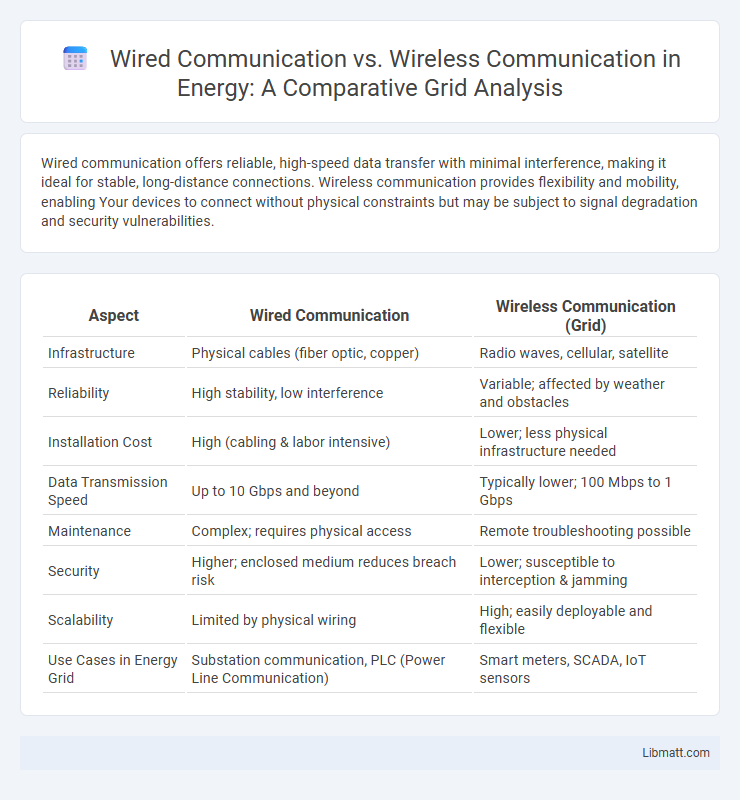Wired communication offers reliable, high-speed data transfer with minimal interference, making it ideal for stable, long-distance connections. Wireless communication provides flexibility and mobility, enabling Your devices to connect without physical constraints but may be subject to signal degradation and security vulnerabilities.
Table of Comparison
| Aspect | Wired Communication | Wireless Communication (Grid) |
|---|---|---|
| Infrastructure | Physical cables (fiber optic, copper) | Radio waves, cellular, satellite |
| Reliability | High stability, low interference | Variable; affected by weather and obstacles |
| Installation Cost | High (cabling & labor intensive) | Lower; less physical infrastructure needed |
| Data Transmission Speed | Up to 10 Gbps and beyond | Typically lower; 100 Mbps to 1 Gbps |
| Maintenance | Complex; requires physical access | Remote troubleshooting possible |
| Security | Higher; enclosed medium reduces breach risk | Lower; susceptible to interception & jamming |
| Scalability | Limited by physical wiring | High; easily deployable and flexible |
| Use Cases in Energy Grid | Substation communication, PLC (Power Line Communication) | Smart meters, SCADA, IoT sensors |
Introduction to Wired and Wireless Communication
Wired communication involves the transmission of data through physical cables such as fiber optics, coaxial, or twisted pair cables, offering high reliability and minimal interference in network grids. Wireless communication relies on radio waves, microwaves, or infrared signals to transmit data without physical connectors, enabling flexibility and mobility across grid systems. Both communication types play critical roles in modern network infrastructure, with wired connections favoring stability and wireless supporting accessibility and rapid deployment.
Key Differences Between Wired and Wireless Communication
Wired communication relies on physical cables like fiber optics and copper wires to transmit data, offering higher stability, security, and faster speeds compared to wireless. Wireless communication uses radio waves or infrared signals to connect devices without physical connections, providing greater flexibility and mobility for your network. Key differences include transmission medium, data transfer rates, installation complexity, and susceptibility to interference and security risks.
Transmission Media Comparison: Cables vs. Airwaves
Wired communication relies on physical cables such as coaxial, fiber optic, and twisted pair to transmit data securely with minimal interference and high bandwidth capacity. Wireless communication uses airwaves, enabling mobility and easier installation but is more susceptible to signal loss, interference, and limited range compared to cables. Your network performance depends on choosing the right transmission media based on factors like data speed requirements, environmental conditions, and scalability needs.
Reliability and Stability: Wired vs. Wireless Networks
Wired communication networks offer higher reliability and stability due to fixed physical connections that are less susceptible to interference and signal degradation. Wireless networks provide greater flexibility but face challenges such as signal interference, environmental factors, and bandwidth limitations that can impact consistent performance. Industrial grid systems often prioritize wired solutions for critical operations requiring uninterrupted data transmission and low latency.
Speed and Bandwidth: Which Delivers More?
Wired communication typically offers higher speed and greater bandwidth compared to wireless communication, with technologies like fiber-optic cables delivering data rates exceeding 100 Gbps and stable, low-latency connections essential for high-demand applications. Wireless communication, including 5G and Wi-Fi 6, provides flexibility and mobility but often experiences lower peak speeds and bandwidth limitations due to interference, signal attenuation, and shared spectrum constraints. For data-intensive, mission-critical tasks, wired grids remain the preferred choice for consistent performance and maximum throughput.
Security Considerations: Wired vs. Wireless
Wired communication offers enhanced security due to its physical connections, reducing risks of unauthorized access and interception common in wireless networks. Wireless communication, while providing convenience and mobility, is more vulnerable to threats like eavesdropping, signal jamming, and unauthorized intrusions, necessitating robust encryption and authentication protocols. Your choice between wired and wireless grid communication should weigh these security trade-offs based on the sensitivity of transmitted data and the network environment.
Installation and Maintenance: Complexity and Costs
Wired communication systems generally involve higher installation complexity and costs due to the need for physical cables, conduits, and labor-intensive infrastructure setup, especially in large grid networks. Wireless communication reduces installation time and expenses by eliminating the need for extensive cabling, but may incur ongoing maintenance costs related to signal interference, equipment updates, and security management. Your choice between wired and wireless grid communication should consider both upfront installation expenditure and long-term maintenance demands to optimize efficiency and budget.
Flexibility and Scalability Analysis
Wired communication systems offer limited flexibility and scalability due to fixed infrastructure and physical cabling, making expansions costly and time-consuming. Wireless communication provides superior flexibility by enabling easy connection of devices without physical constraints and supports scalable network growth through adaptable frequency bands and technologies like Wi-Fi 6 and 5G. Scalability in wireless grids is enhanced by mesh networking capabilities, allowing dynamic reconfiguration and integration of numerous nodes without significant infrastructure changes.
Applications and Use Cases: Choosing the Right Grid
Wired communication grids are essential in applications requiring stable, high-speed data transfer, such as data centers, industrial automation, and smart grids with extensive sensor networks. Wireless communication grids offer flexibility and ease of deployment in remote monitoring, agricultural IoT, and emergency response systems where mobility and rapid installation are critical. Selecting the appropriate grid depends on factors like bandwidth requirements, environmental conditions, scalability, and latency tolerance to optimize performance and reliability.
Future Trends in Wired and Wireless Communication
Future trends in wired communication emphasize the deployment of fiber optic networks offering ultra-high-speed data transfer and enhanced reliability for smart grids and industrial IoT applications. Wireless communication advancements focus on 5G, 6G, and beyond, enabling massive device connectivity and low-latency transmissions critical for autonomous systems and real-time grid monitoring. Integration of hybrid communication architectures leverages the strengths of both wired and wireless technologies to optimize efficiency, security, and scalability in next-generation communication grids.
Wired Communication vs Wireless Communication (Grid) Infographic

 libmatt.com
libmatt.com